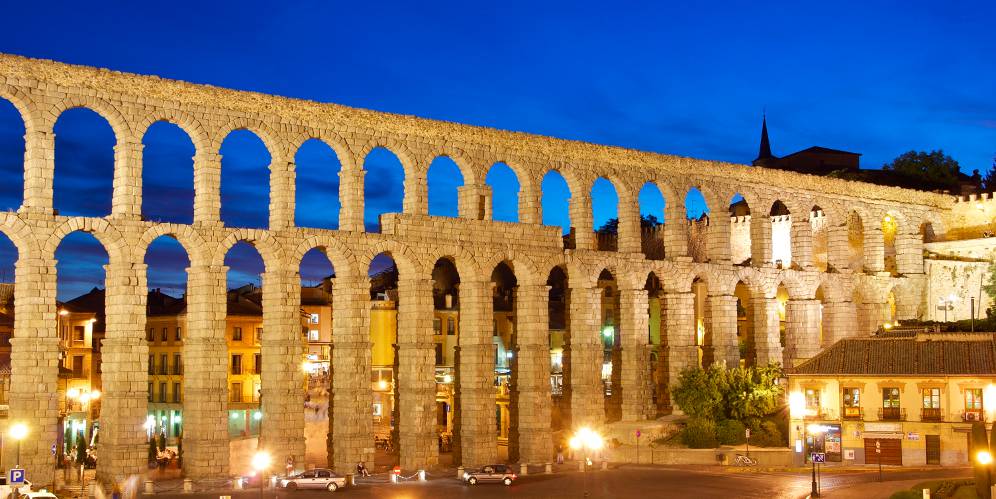About-Spain.net
- discover the real Spain
| Spain's historic heritage ► | Roman
Spain |
Moorish
heritage |
Walled cities |
| Churches & cathedrals | Top Spanish museums | Castles and fortresses |
Roman
and classical Spain
1. Spain's best classical antiquities

Mérida,
Extremadura - the Temple of Diana.
While sites such as the aqueduct at Segovia and the many Roman remains at Merida or Tarragona have been well-known for centuries, other sites are still only being brought to light in the twenty-first century. Though archeological excavations have been carried out for many years on the Roman villa at Noheda, near Cuenca, it is only recently that the full extent of the fine mosaics has been revealed. Near Palencia, the remains of the La Olmeda villa were not properly excavated until 1968; its fine late Roman mosaics have now been properly preserved and are on public view.

Detail of the exquisite charioteer mosaic, Museum of antiquity, Mérida
Major
Roman sites in Spain
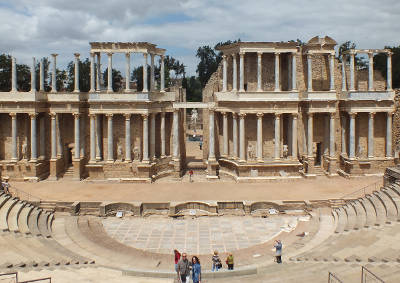
Mérida - the Roman theatre
- Merida (Extremadura) : (UNESCO world heritage site) - Capital of the Roman province of Lusitania, Mérida boasts the finest ensemble of Roman remains in Spain. Roman amphitheatre, arena, temple to Diana, villa, long Roman bridge and well-preserved stadium, plus the aqueduct of Los Milagros on the outskirts of the city. Spanish national museum of classical antiquity
- Segovia (Castilla y Leon) : (UNESCO world heritage site) - Roman aqueduct (photo top) - still in use today.
- Tarragona (Catalunya): (UNESCO world heritage site) In town: Roman amphitheatre, Praetorian tower, Roman circus. Out of town: Roman aqueduct, located on the northern outskirts of town, and also the Roman triumphal arch Arco de Berà / de Bara, located on the old Via Augusta 20 km northeast of Tarragona.
- Italica (near Seville, Andalucia) : Large archaeological site, with impressive Roman amphitheatre and mosaics
- Alcantara (Extremadura) : very fine Roman bridge over the river Tagus (photo below). This bridge has remained in virtually continuous use since Roman times, and today carries road traffic.
- Toledo
(Castilla la Mancha) : The Alcantara Roman bridge over
the Tagus
(Several tourism websites confuse these two bridges, or consider them to be the same bridge; they are about 300 km apart)
Find
places to stay near major Roman sites in Spain
About-Spain.net
is partnered with Booking.com
to bring you best rates on hotels. Check out the following
areas :
Segovia
Mérida
Toledo
Alcantara
A
Coruña Ampurias Las Médulas Tarragona Other areas
- Lugo (Galicia) : Roman walls - reputedly the world's finest surviving example of Roman city walls.
- Ampurias / Empúries (Catalonia) : It was here on the Mediterranean coast, on what is now the Costa Brava, that the Romans first established a foothold in Hispania. Remains of a Roman city, near L'Escala
- Baelo Claudia (Andalucia) : remains of a Roman city on the Atlantic coast, 22 km northwest of Tarifa. Basilica, Roman theatre, and other civil buildings including an interesting fish-salting works.
- A Coruña (Galicia) : (UNESCO world heritage site) The Tower of Hercules - Roman lighthouse in service since the second century. Renovated in 1791, but still essentially a Roman building.
- Las Médulas (Castile and León) (UNESCO world heritage site) Near Ponferrada in the region of El Bierzo, once the most important gold mine in the Roman Empire. Impressive landscapes and exhibits.
- Segobriga, near Tarancon (Castile la Mancha) - In the middle of the countryside 100 km southeast of Madrid, Segobriga is one of Spain's surprisingly little-known historic sites. The partly excavated Roman town has a well-preserved amphitheatre and theatre, plus many more remains as well as a small interpretive centre / museum.
- Near Cuenca (Castile la Mancha) - The Roman Villa at Noheda . Recently uncovered, a large villa complex with some of the finest Roman mosaics in the world. Visits by appointment : a museum is being built.
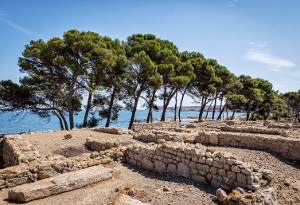
Remains of
the Roman city at at Ampurias
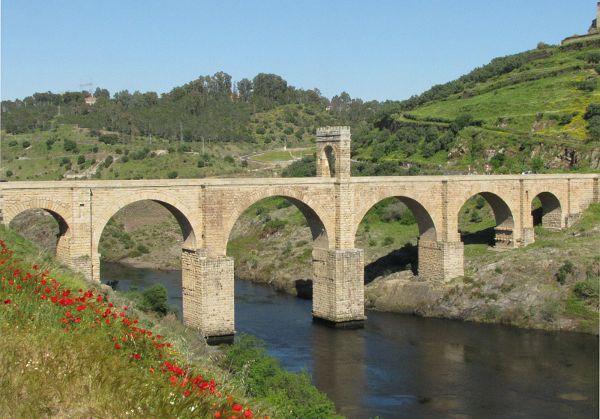
The
Roman bridge over the Tagus at Alcántara, Extremadura....
still in use
Continue to...
► Moorish Spain - Roman Spain - Castles in Spain
Other pages of interest : Travel in Spain - Food and eating in Spain
► You may also like : Undiscovered France
► Moorish Spain - Roman Spain - Castles in Spain
Other pages of interest : Travel in Spain - Food and eating in Spain
► You may also like : Undiscovered France
Top
photo: Roman
aqueduct, Segovia
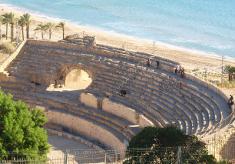
Seaside amphitheatre at Tarragona, Catalunya
Not surprisingly, given the fact that Roman civilisation
lasted in
Hispania for over six centuries, there are Roman remains all over
Spain, many of them unreferenced in all but the most detailed and local
tourist guides. One such location is Segobriga – the
extensive remains
of a Roman
town with theatre, well-preserved amphitheatre, and vestiges of other
Roman edifices, now in the middle of nowhere 100 km southeast of
Madrid. Another is Coria, in Extremadura well off the tourist trail,
which has some well preserved Roman city walls.
This page is an introduction to the best Roman sites in Spain, and also to some of those that are a lot less well-known
This page is an introduction to the best Roman sites in Spain, and also to some of those that are a lot less well-known

Seaside amphitheatre at Tarragona, Catalunya
| ►► Spain - a thematic guide: |
| Spain - the country Essential information about Spain. |
| Travelling
in Spain Getting round in Spain - by car, by coach by train, or on foot |
| Tourism
in Spain
Where to go and what to see |
| The coasts of spain |
| Top attractions in Spain |
| Andalucia |
| Eastern Andalucia |
| Western Andalucia |
| Asturias |
| Castile y Leon |
| Castile La Mancha |
| Extremadura |
| Valencia |
| Undiscovered Spain |
| Map of the Spanish regions |
| Accommodation
in Spain Where to stay, and the different options available |
| The
Spanish
way of life Spain is different; all you need to know about Spanish habits, including |
| Spanish food and eating |

